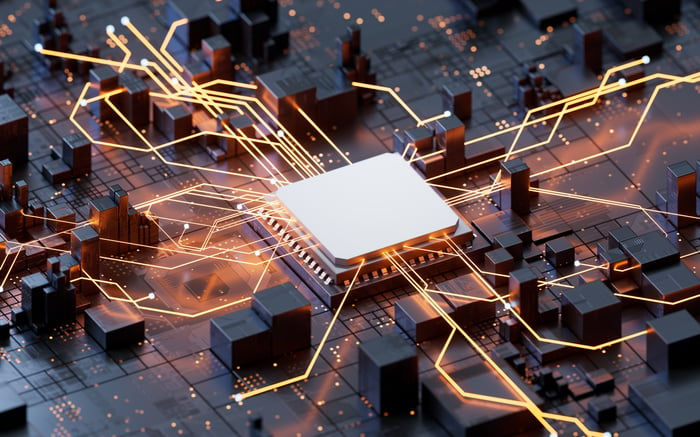Intel Shares Surge on Nvidia Investment. Is It Too Late to Buy the Stock?

Key Points
Intel's shares soared after it announced a partnership and investment from Nvidia.
The companies will collaborate on a GPU-CPU chip combination.
While the partnership with Nvidia is positive, it doesn't solve all of Intel's problems.
Intel (NASDAQ: INTC) just had one of its best days in years, with its stock price surging after Nvidia (NASDAQ: NVDA) revealed it would take a $5 billion stake in the chipmaker and partner on new products. The stock price is now up about 50% on the year.
While the market loved the deal, it is worth taking a closer look at what this deal really means for Intel and whether this is a true turning point or just a short-term jolt.
Where to invest $1,000 right now? Our analyst team just revealed what they believe are the 10 best stocks to buy right now. Learn More »

Image source: Getty Images.
Why Nvidia is partnering with Intel
The collaboration between Nvidia and Intel appears largely aimed at rival Advanced Micro Devices (NASDAQ: AMD). AMD's central processing units (CPUs) have been steadily taking share from Intel in both the data center and computer segments. Meanwhile, the company has started to fuse its graphics processing units (GPUs) and CPUs together, which is a direct challenge to Nvidia. However, thus far, most of its success in this area has been in gaming and computers and not in artificial intelligence (AI).
Nonetheless, Nvidia does not appear content to just dominate the massive data center market, and with this collaboration, it will look to address the laptop market as well. It also looks to stave off any advantages that AMD may gain in the data center market with a combined GPU/CPU chip, especially as the market moves more toward inference.
As such, the companies will look to combine Intel CPUs with Nvidia GPUs connected by NVLink, giving laptop buyers an integrated option that is much more powerful. Intel will also build custom x86 CPUs for Nvidia's rack-scale servers, making Nvidia a major customer for its chips. That is a big win for Intel, given how much share it has lost to AMD in the data center over the past five years. For Nvidia, this is about making sure AMD doesn't gain too much ground with its own combined CPU/GPU solutions.
While the $5 billion investment is a drop in the bucket for Nvidia, it does matter for Intel. Intel has been burning through cash trying to scale its foundry business and build new fabs in the U.S. and Europe. Its foundry operating losses were $3.2 billion last quarter, worse than a year ago.
The Nvidia capital injection, along with $9 billion from the U.S. government and $2 billion from SoftBank, gives Intel a $16 billion war chest to keep investing without wrecking its balance sheet. It also signals to the market that Nvidia sees Intel as too important to fail. The company may be a competitor in some markets, but Nvidia apparently wants a strong CPU partner to keep AMD from getting too much leverage in the CPU market.
Is Intel's stock a buy?
Despite the stock's huge jump, there are still plenty of risks with the Intel story. Intel's core PC business remains soft, with client computing revenue down 3% year over year last quarter. Its data center and AI segment revenue grew just 4%, which was far behind the booming numbers from Nvidia and even AMD.
And while the company says its product roadmaps remain on track, its recent history is not good, with the company often missing deadlines or even scrapping products. In addition, Nvidia said that it is not giving up on the CPUs it has been developing with Arm Holdings.
Intel's money-losing foundry business is also an issue, and it does not sound like Nvidia is riding to the rescue with regard to this part of its business. Nvidia has made clear that it is not moving away from Taiwan Semiconductor Manufacturing as its primary manufacturing partner. Intel doesn't have the expertise or scale of TSMC, so Nvidia is still very reliant on the foundry leader.
While the partnership with Nvidia is a positive, it doesn't solve all of Intel's problems. It still needs to prove it can execute and that all the money it's pouring into its foundry business will pay off. Gaining Nvidia as a foundry customer likely would have been a bigger deal, but that was not the case.
Meanwhile, after the jump in its stock price this year, the stock is no longer in the bargain bin. As such, I wouldn't chase the rally.
Should you invest $1,000 in Intel right now?
Before you buy stock in Intel, consider this:
The Motley Fool Stock Advisor analyst team just identified what they believe are the 10 best stocks for investors to buy now… and Intel wasn’t one of them. The 10 stocks that made the cut could produce monster returns in the coming years.
Consider when Netflix made this list on December 17, 2004... if you invested $1,000 at the time of our recommendation, you’d have $661,694!* Or when Nvidia made this list on April 15, 2005... if you invested $1,000 at the time of our recommendation, you’d have $1,082,963!*
Now, it’s worth noting Stock Advisor’s total average return is 1,067% — a market-crushing outperformance compared to 190% for the S&P 500. Don’t miss out on the latest top 10 list, available when you join Stock Advisor.
*Stock Advisor returns as of September 22, 2025
Geoffrey Seiler has no position in any of the stocks mentioned. The Motley Fool has positions in and recommends Advanced Micro Devices, Intel, Nvidia, and Taiwan Semiconductor Manufacturing. The Motley Fool recommends the following options: short November 2025 $21 puts on Intel. The Motley Fool has a disclosure policy.



-8fe429c75f0a48aa94f43d6c5c639094.jpg)

_croped_889x500 (1)-666c3deec8f74a1d91bccfc0edb42909.jpg)
.jpg)
